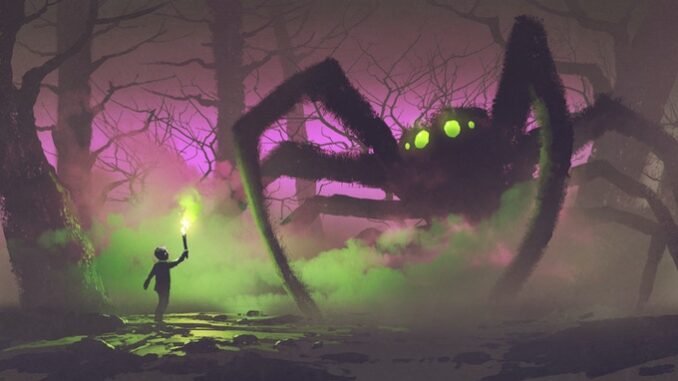
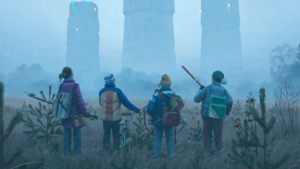
A surge of RPGs prominently featuring a single artist creating all of the art from cover through interiors has graced the gaming world. In some cases, these publications blur the line between RPG and art book as they give rise to beautifully illustrated games like Tales from the Loop based on Simon Stålenhag’s art, Kwanchai Moriya’s work on Overlight: A Fantasy Roleplaying Game of Kaleidoscopic Journeys, and Dejan Mandic’s interiors for ZWEIHÄNDER Grim & Perilous RPG. RPGs that use a single artist for every image insure a uniform look and presentation of ideas. Mihajlo Dimitrievski handles all of the illustrations for The North Sea Epilogues (reviewed here) as well as the North Seas board games. This is not a new publishing strategy as artists such as Brom and Tony DiTerlizzi were the backbone of entire TSR product lines. But, it’s returning to popularity as can be seen in numerous crowdfunding campaigns.
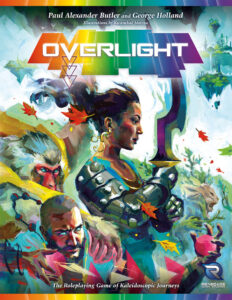
A month ago, I looked at pieces of RPG stock art including work by Tithi Luadthong dissecting how stock art works and why it’s a win. Generally, projects that use stock art tend to pull from multiple artistic sources to pool enough images to populate a book. By comparison, single-artist RPGs embrace a uniform visual (and a larger art budget) to create something that leaps from the screen and printed page. These type of projects originated as an art director concept but have evolved into an organic product driven by creators, both solo and in tandem with writers, that are crafting their own games that compliment and feature art.
To get an idea of why these projects are growing in popularity, I spoke with several publishers that have crowdfunded single-artist RPGs.
Why did you choose to do a book with a single artist?
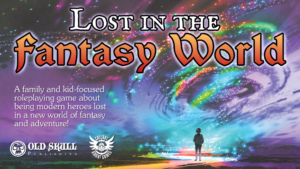
Diogo Nogueira of Old Skull Publishing (DN): In the case of Lost in the Fantasy World, since the game draws a lot from my experience with children’s literature, I wanted to make an RPG that looked like a children’s book. Tuthi Luadthong art just transpires the fantastic world I imagined the characters would be transported to, and the dream-like atmosphere it invokes was perfect for the game, so we made an effort and worked to make the whole book with Tuthis’ artwork. I am making another game with a single artist, called The Bloody Axe of X’Zara. In this case, Felipe Faria’s work was so good and seeing how fast he worked, I thought it would be a great opportunity to showcase his art and make a more uniform presentation of the game.
Craig Campbell of Nerdburger Games (CC): Having a single artist do all of the artwork in CAPERS (and now four supplements) was a good way to go for a variety of reasons. First, I already had a good working relationship with artist Beth Varni from her doing some of the artwork on Murders & Acquisitions. I knew what to expect from her work and from the process of working with her.
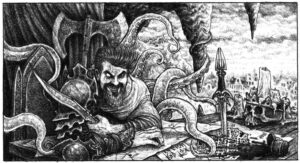
Second, it helped create a truly uniform and cohesive style across the core book and supplements. Beth primarily works in indie comics, so her style was appropriate to a game about super-powered people in the Roaring Twenties.
Finally, it made being an art director and producer easier. I make RPGs in my spare time, and streamlining the process with a single artist meant I didn’t have to spend as much time coordinating different artists’ looks, creating multiple contracts, corresponding with different artists, and so forth.
Brandon K. Aten of Wet Ink Games (BKA): Our first project with a single artist, Never Going Home, allowed us to maintain a unified art style throughout the book. A lot of the art was licensed from Charles Ferguson-Avery from his original art book, but we also worked with him to develop more art for the rest of the book. This allowed the new art to compliment and build off of the previous art, and it all still felt the same. We’ve worked with single artists on other projects too. Tenebria: Remnant of Rome is another project where the artist, in this case Steven Wu, was able to really lean into some of the ideas he had worked on before and was able to flesh them out how he wanted, while working with our creative director.
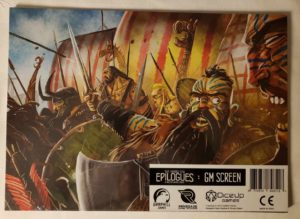
As a publisher, do you see the projects you’ve produced with a single artist as akin to art books or do you feel they hew closer to a better art directed RPG?
DN: In the case of Lost in the Fantasy World, it’s a little bit of both. It’s a children’s book style that is close to an art book in my opinion. It’s a big selling point of the game, yes. In the case of The Bloody Axe of X’Zara, I think it’s just the case of making a more uniform game, that has its brand, you know? Having an artist associated with all the art of the game makes that art remind everyone of that game. I like games with multiple artists too. I love DCC’s art and style, even though they use many different artists. They each see the game in a different way, like every group will play the same game differently. But with more focused games, defined settings, having a single artist helps a lot!
CC: The CAPERS products have a pretty good art to page count ratio, but I wouldn’t call them art books. The graphic design (with nods to early-to-mid-century magazines) coupled with the consistent art style makes for a cohesive package for the game line. But they’re definitely game books.
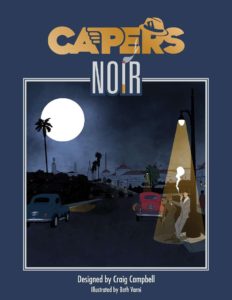
BKA: I can easily see how someone might consider them art books, since you are able to focus on the style and aesthetic of one particular artist, but ultimately a gamer is purchasing a product to play a game, and the art can help bring that game to life. Working with a single artist both highlights their work and the work of the writers and designers who make the game what it is. We at Wet Ink Games do our very best to provide a complete artistic product which is a full culmination of writing of both setting and fiction, design, and art that someone can value as an entire experience.
The single writer and single artist team is common in comic books, illustrated novels, and children’s books, but less so in RPGs. What advantages do you see for publishers that want to work with a smaller creative team?
DN: The main advantage, as I said, is to have a unified identity, making your game stand out. They see the art and they immediately associate it to your game. Like when you see Doug Kovacs’ art and associate it with DCC RPG. If everyone works professionally, it’s also much easier to manage, of course, and having a real partnership can improve the work overall, as the writer and artists can influence and enrich each other’s work. But that requires trust and openness.
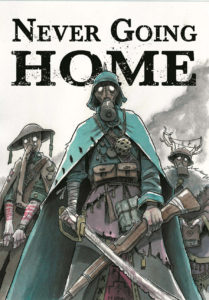
CC: It’s easier to streamline the process when you focus on a smaller team. There are less people to keep up to speed, less chance of misunderstandings and failed direction, less coordination. Additionally, it gives the individual freelancer (be they artist or whatever) a chance to feel a greater sense of (co-)ownership of the project. The more invested a team member is, the more likely they are to put a little something extra into the project. And extra effort and care put in at all levels helps to create a product that’s better than it might have been otherwise.
BKA: One of the best and most immediate benefits is having a single point of contact. Working with a single artist helps build the relationship with that artist as they become more comfortable with the setting and material you’re putting together, especially as the product line expands. They understand the style you’re working towards and can often anticipate your needs or wants. It’s the same way with working with the same writer or publisher repeatedly. You know what they want and you try to deliver that.
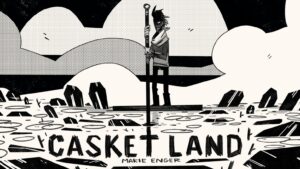
The publishers come to many of the same conclusions, greater participation from the artist leads to improved work and fans can associate that work with the product.
Beyond their feedback, there are numbers to support these assertions. Below is a selection of artists as well as the results of their single-artist RPG Kickstarters. While this is not an exhaustive list, the numbers tell a story and point towards the success of these projects.
Marie Enger, the writer and artist behind:
-
CASKET LAND – Powered by the Apocalypse zine – 1,399 backers pledged $21,722
-
CASKET LAND – CRUACH – Powered by the Apocalypse zine – 992 backers pledged $19,009
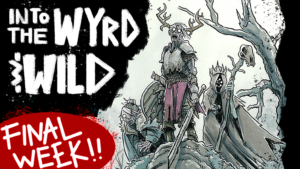
Charles Ferguson-Avery, the artist behind:
-
Never Going Home: World War Occult Role Playing – 786 backers pledged $33,188
-
Never Going Home Campaign Dossiers – 352 backers pledged $22,591
-
Into the Wyrd and Wild – 1,542 backers pledged $59,284
-
They Cried Monster – OSR zine – 394 backers pledged $4,373
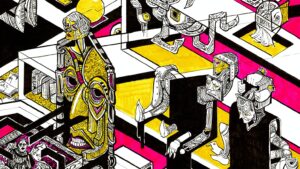
Dirk Leichty, the artist behind:
-
Silent Titans – 995 backers pledged $55,109
-
SUPER BLOOD HARVEST – 303 backers pledged $12,209
Alec Sorensen, the artist behind:
-
Electric Bastionland RPG – 1,625 backers pledged £57,514
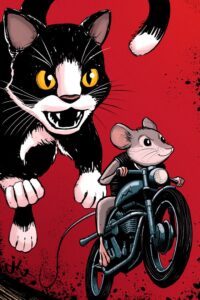
Jacob Hunt, the artist behind:
- Heavy Metal Thunder Mouse – 424 backers pledged $7,937
Johan Nohr, the artist behind:
- MÖRK BORG – 1,152 backers pledged SEK 489,252 [NOTE: Generally, it requires 10 Swedish Krona to equal a US Dollar]
- MÖRK BORG CULT: FERETORY – 1,762 backers pledged SEK 612,916
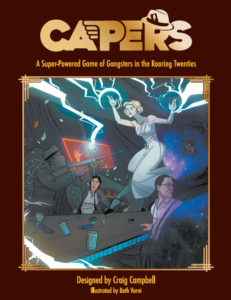
Beth Varni, the artist behind:
- CAPERS RPG – 532 backers pledged $10,256
- CAPERS Noir RPG – 377 backers pledged $7,577
- CAPERS Covert RPG – 306 backers pledged $5,585
- CAPERS RPG Deluxe Hardcover – 254 backers pledged $11,408
- CAPERS Offworld RPG – 266 backers pledged $5,332
In all likelihood, publishers will continuing to grow this market and produce more single-artist RPGs.
I want to thank Brandon K. Aten of Wet Ink Games (in the past, I spoke with Brandon about Never Going Home here and here), Craig Campbell of Nerdburger Games (I’ve attended many shows with Craig and reviewed CAPERS), and Diogo Nogueira of Old Skull Publishing (I reviewed Diogo’s RPG, Dark Streets & Darker Secrets, here) for sharing their insights. I also want to highlight the game that Diogo mentioned since it’s running on Kickstarter right now:
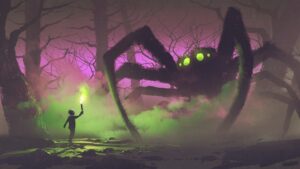
Lost in the Fantasy World
By Gallant Knight Games and Old Skull Publishing
END DATE: Fri, June 12 2020 12:00 PM EDT.
Designed and Written by Diogo Nogueira
Art by Tuthi Luadthong
“A family and kid-focused roleplaying game about being modern heroes lost in a new world of fantasy and adventure!”
Egg Embry participates in the OneBookShelf Affiliate Program. This program provides advertising fees by linking to DriveThruRPG.
Latest posts by Egg Embry (see all)
- New Gamemaster Month 2023 - January 20, 2023
